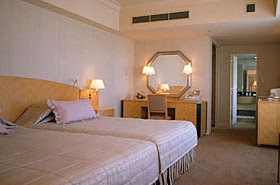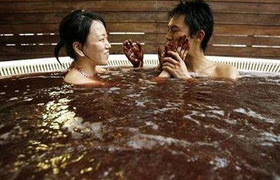Okura Fukuoka Luxury Hotel in Fukuoka Japan
 The Okura Fukuoka Hotel is a five-star luxury hotel, located in the heart of the Hakata Riverain complex on the banks of the Naka River.
The Okura Fukuoka Hotel is a five-star luxury hotel, located in the heart of the Hakata Riverain complex on the banks of the Naka River.Set within this elegant entertainment area, complete with designer shops, restaurants, the Fukuoka Asian Art Museum, and the Hakataza Theater, the Okura Fukuoka Hotel is perfectly placed for both the business and leisure traveler to Fukuoka.
Accomodation and Facilities in Okura Fukuoka Hotel Japan
 Setting new standards in service, the Okura Fukuoka Hotel embodies the Japanese tradition of warm hospitality in a stylish and sophisticated atmosphere.
Setting new standards in service, the Okura Fukuoka Hotel embodies the Japanese tradition of warm hospitality in a stylish and sophisticated atmosphere.Combining simplicity with elegance, each of the 267 guest rooms at the Okura Fukuoka Hotel is beautifully furnished with a selection of high-quality amenities, with an emphasis on comfort and convenience.
Hotel facilities at the Okura Fukuoka Hotel include a fully equipped gymnasium, an indoor swimming pool, saunas. Experience the time of your life at the Hotel Okura Fukuoka Japan.
Okura Fukuok Hotel Japan: 3-2 Shimokawabata-machi Hakata-ku, Fukuoka 812-0027 Japan











 The Japanese plum or ume (sometimes referred to as Japanese apricot) has played an important role in Japanese culture for many centuries. It was originally introduced from
The Japanese plum or ume (sometimes referred to as Japanese apricot) has played an important role in Japanese culture for many centuries. It was originally introduced from  Kairakuen (Ibaraki Prefecture): Mito Station, JR Joban Line Ranked as one of Japan's three finest landscape gardens, Kairakuen features over 3000 plum trees of 100 varieties. A plum festival is held annually from February 20 to March 31.
Kairakuen (Ibaraki Prefecture): Mito Station, JR Joban Line Ranked as one of Japan's three finest landscape gardens, Kairakuen features over 3000 plum trees of 100 varieties. A plum festival is held annually from February 20 to March 31. A Japanese spa is offering the perfect aphrodisiac for Valentine's Day chocolate baths. Those who just can't get enough of the sweet stuff can immerse themselves in water mixed with cacao and fragrant bath powders. Twice a day, staff pour creamy chocolate over the bathers, who smear it over their bodies or lick it off.
A Japanese spa is offering the perfect aphrodisiac for Valentine's Day chocolate baths. Those who just can't get enough of the sweet stuff can immerse themselves in water mixed with cacao and fragrant bath powders. Twice a day, staff pour creamy chocolate over the bathers, who smear it over their bodies or lick it off.








